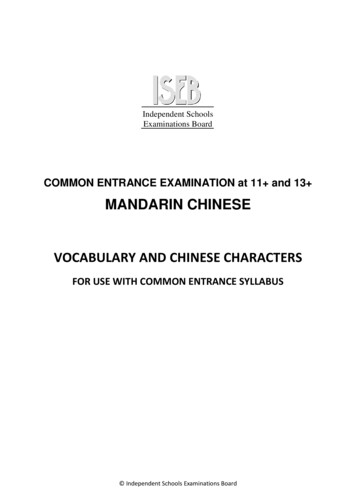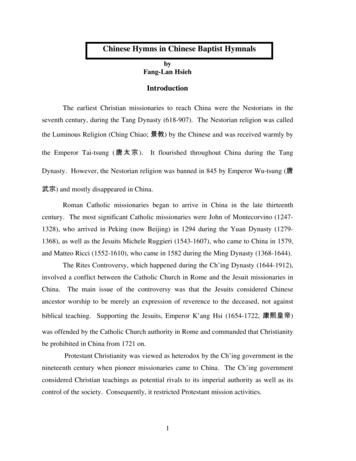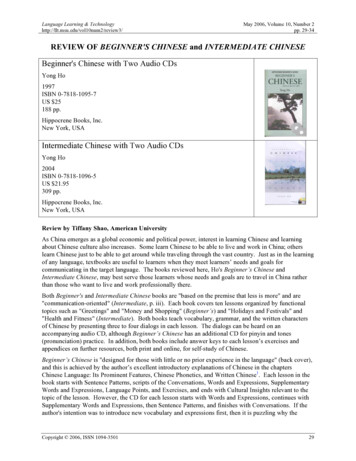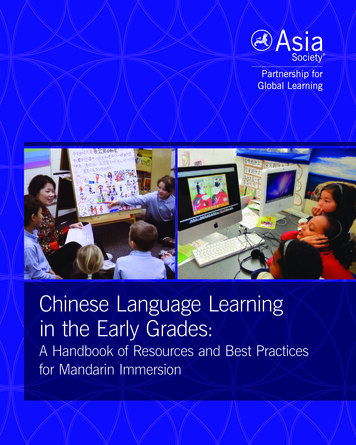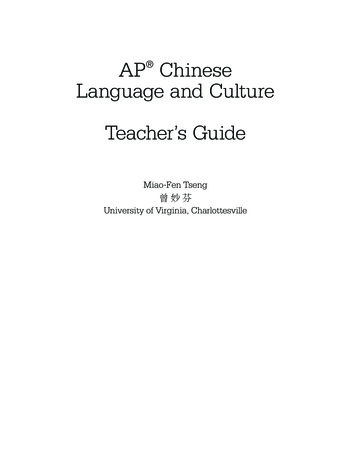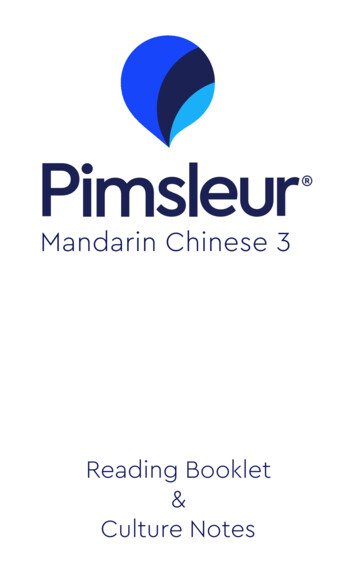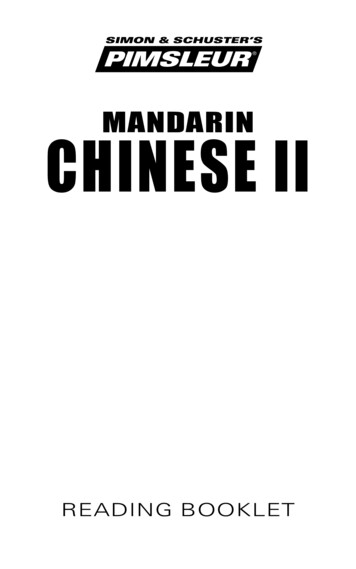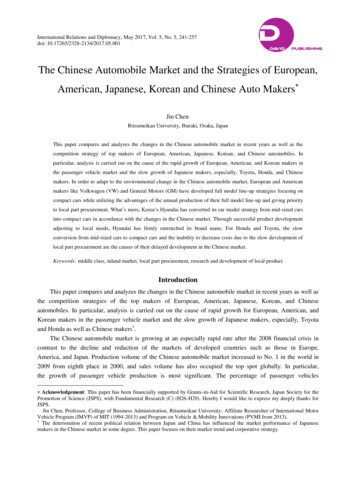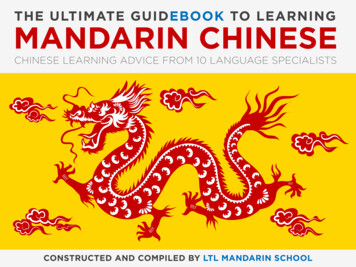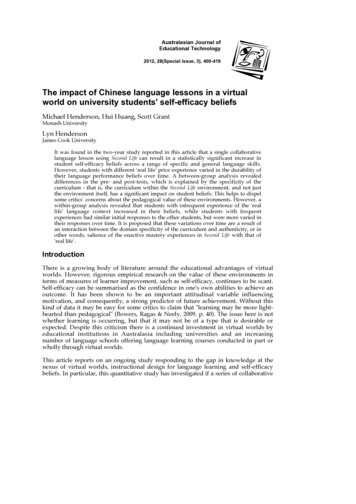
Transcription
Australasian Journal ofEducational Technology2012, 28(Special issue, 3), 400-419The impact of Chinese language lessons in a virtualworld on university students' self-efficacy beliefsMichael Henderson, Hui Huang, Scott GrantMonash UniversityLyn HendersonJames Cook UniversityIt was found in the two-year study reported in this article that a single collaborativelanguage lesson using Second Life can result in a statistically significant increase instudent self-efficacy beliefs across a range of specific and general language skills.However, students with different 'real life' prior experience varied in the durability oftheir language performance beliefs over time. A between-group analysis revealeddifferences in the pre- and post-tests, which is explained by the specificity of thecurriculum - that is, the curriculum within the Second Life environment, and not justthe environment itself, has a significant impact on student beliefs. This helps to dispelsome critics' concerns about the pedagogical value of these environments. However, awithin-group analysis revealed that students with infrequent experience of the 'reallife' language context increased in their beliefs, while students with frequentexperiences had similar initial responses to the other students, but were more varied intheir responses over time. It is proposed that these variations over time are a result ofan interaction between the domain specificity of the curriculum and authenticity, or inother words, salience of the enactive mastery experiences in Second Life with that of'real life'.IntroductionThere is a growing body of literature around the educational advantages of virtualworlds. However, rigorous empirical research on the value of these environments interms of measures of learner improvement, such as self-efficacy, continues to be scant.Self-efficacy can be summarised as the confidence in one's own abilities to achieve anoutcome. It has been shown to be an important attitudinal variable influencingmotivation, and consequently, a strong predictor of future achievement. Without thiskind of data it may be easy for some critics to claim that "learning may be more lighthearted than pedagogical" (Bowers, Ragas & Neely, 2009, p. 40). The issue here is notwhether learning is occurring, but that it may not be of a type that is desirable orexpected. Despite this criticism there is a continued investment in virtual worlds byeducational institutions in Australasia including universities and an increasingnumber of language schools offering language learning courses conducted in part orwholly through virtual worlds.This article reports on an ongoing study responding to the gap in knowledge at thenexus of virtual worlds, instructional design for language learning and self-efficacybeliefs. In particular, this quantitative study has investigated if a series of collaborative
Henderson, Huang, Grant and Henderson401Chinese language lessons in Second Life could sustain or improve university students'self-efficacy beliefs about language performance. The lessons (tutorials) were held oncampus in a teaching room with a computer for each student, but were conducted inSecond Life. The lessons under scrutiny were specifically focussed on Chinese languageand culture content previously covered in the classroom and in the textbook. Studentswere expected to choose appropriate vocabulary and correct grammatical structures ina dynamic, semi-spontaneous scenario to communicate with fellow learners and theteachers to achieve the designated tasks.The first year of data (Henderson, Huang, Grant & Henderson, 2009) revealed a strongstatistical significance (p .01, n 100) in the increase in self-efficacy beliefs aboutlanguage performance with moderate (eta2 0.06) to large (eta2 0.14) effect sizes afteronly one lesson. However, several concerns were also reported (Henderson et al.,2009), such as resilience beyond the lesson, domain specificity and construct validity.As a result of the highly positive but potentially problematic findings, a further studyof 81 students over two lessons was conducted and is the focus of this article. Thefindings offer additional insights, but also reinforce the fact that the relationshipbetween Second Life lessons and self-efficacy beliefs is far from simple.Affordances of virtual worlds for language learningVirtual worlds such as Second Life are particularly well suited for teaching and learningsecond languages. Students can immerse themselves in linguistically appropriateenvironments (e.g. Chinese restaurant with Mandarin signs, menus, etc), adopt rolesand even identities that can provide a rich affective and cognitive model for languageperformance, as well as interact and collaborate with others to achieve complex goalsthrough pedagogically appropriate media such as text, voice and video. Second Life isable to support competency-based training in areas such as vocabulary and grammarlike other computer-assisted language learning tools do, and in addition can alsofacilitate synchronous interaction between teachers, students and others, includingnative speakers, in rich, creative ways. A synthesis of the research literature spanningvirtual worlds and language learning was conducted, the outcomes of which werecoupled with the authors' experiences in teaching within virtual worlds to identifyeight key affordances. These affordances are presented in Table 1.Virtual worlds in second language acquisition and intercultural awareness requirefurther research. Our understanding of the role of virtual worlds in languageacquisition continues to be heavily based on text-based multi-user virtualenvironments such as MUDs and MOOs. However, virtual worlds add much morethan visual and auditory media; they offer instructors and students greater choices forcollaboration, learner autonomy, creativity and experimentation, including identityplay and formation.Virtual worlds are potentially valuable environments for learning a second languageand for intercultural awareness. This study investigates the impact of a Second Lifeexperience on students’ self-efficacy beliefs. Measuring performative data, such asstudent knowledge of Chinese language in a pre- and post-test, can only tell us whatthe students have learnt. Self-efficacy, on the other hand, has been shown to be astrong predictor of future achievement.
402Australasian Journal of Educational Technology, 2012, 28(Special issue, 3)Table 1: Virtual world affordances for language learningAffectivefilterPersistentenvironments andrecordsPhysicaland linguistic copresenceAvatarcontrolandlearnerautonomyThe valueof textinteractions, evenin a virtualworldexperienceIt is proposed that virtual presence can result in reduced apprehension andembarrassment that otherwise can impede experimentation such as through roleplaying. Sanchez (1996) notes this in relation to text-based virtual worlds, and it issupported by Schwienhorst (2002) in relation to graphically rich environments*.Moreover, Schwienhorst points out that role-play in this context "should not bemisunderstood as role-playing as in 'at the train station' scenarios in some languageclassrooms but in the more fundamental sense of using alternative personas toapproach potentially construct-altering situations" (p. 202). In face to face classroomenvironments, student language learning outcomes can suffer from what has beentermed "foreign language classroom anxiety" (Backer, 1999; Horwitz, Horwitz &Cope, 1986; Zhao & Lai, 2009), particularly at the output stage (Hauck & Hurd,2005). This affective filter arises because of learner perception of a threateningenvironment in the form of negative feedback from classmates or the instructor,prompted by their attempt at producing output in the language being learnt. The useof virtual worlds for language learning has been shown to reduce such anxiety(Access to Virtual and Action Learning Live ONline, 2010; Hundsberger, 2009;Peterson, 2011; Rankin, McNeal, Shute & Gooch, 2008).Virtual worlds are persistent - that is, the environment (e.g. Chinese restaurant) andthe objects (e.g. Chinese menu) do not disappear at the end of the lesson, unlessprogrammed to do so. This is also true of records of activity, including transcripts oftext-based dialogue. Consequently, users can return to the place of their learning,interact with the objects and, depending on the instructional design, peruse recordsof the event (Bell, 2008). Schwienhorst (2002) argues that persistent records ofinteraction allow students to "critically examine their own performance, or rather,the performance of their virtual selves" (p. 202). This is further supported by Thorne(2008), who found that lingering utterances (on-screen or recalled via 'chat history')facilitated language learning and were also particularly valuable for use to provideindividual learners with crucial feedback on their language performance.The immersive social environment of virtual worlds provides a range of discourseelements that are generally not available in less immersive environments. Forexample, indexical language (here, this, etc) is often problematic in teleconferencingor other computer-mediated communications (Schwienhorst, 2002). Hence, the valueof virtual worlds is that it merges the physical co-presence and linguistic co-presenceof the interlocutors (Schwienhorst, 2002). Both types of co-presence are importantelements in discourse, and facilitate learning through the negotiation of mutualknowledge (Clark & Marshall, 1981). In addition, Dalgarno and Lee (2010) maintainthat co-presence allows learners to "engage simultaneously in shared tasks and/orproduce joint artefacts by operating on the same objects in real time", which can"pave the way for rich and truly collaborative experiences that foster positiveinterdependence within a learning group" (p. 22).Students control their avatars to explore and interact, independent of the instructor.While this autonomy is limited by software and environmental design, it does affordstudent-centred learning. At the simplest level, students can form (or be directed toform) groups and collaborate in similar ways to classroom interactions. Unliketypical discussion forum or text chat learning environments, students candynamically create and reshape groups according to pedagogical imperatives orinterpersonal and social dynamics. Schwienhorst (2002) points out that theaffordance of learner autonomy in supporting experimental, learner-centredenvironments can raise language and linguistic awareness and performability aswell as support complex thinking and critical reflection. Collentine (2011) confirmedthat there is a positive correlation between learner autonomy in 3D virtualenvironments and the linguistic complexity and accuracy of learner production.It is proposed that virtual worlds such as Second Life can provide a contextually richenvironment (e.g. with graphics, animation, audio and text stimuli) that can serve aspowerful cognitive aids to text-based interactions. Simply because Second Life cansupport voice does not mean that it is always the most appropriate medium for thelearning outcomes being targeted. Indeed, the research literature from languageeducation in general and computer-mediated language education in particularreveals that writing not only improves written language skills, but also facilitatesorality as well as linguistic and metalinguistic awareness (Beauvois, 1998; Chun &Plass, 2000; O'Rourke, 2005; Schwienhorst, 2002; Sykes, 2005; Thorne, 2008; Wells,1981). Ma's (1996) research in text-based virtual worlds also revealed a greater levelof self-disclosure, egalitarianism and intercultural awareness than found in face toface exchanges between East Asian and North American college students. Forstudents learning character-based languages like Chinese, text-based interactionsalso provide the opportunity to consolidate knowledge of Hanyu pinyin romanisationand character recognition (Grant & Clerehan, 2011).
Henderson, Huang, Grant and Henderson403in a virtual learning outcomes being targeted. Indeed, the research literature from languageworldeducation in general and computer-mediated language education in particularexperience reveals that writing not only improves written language skills, but also facilitatesorality as well as linguistic and metalinguistic awareness (Beauvois, 1998; Chun &Plass, 2000; O'Rourke, 2005; Schwienhorst, 2002; Sykes, 2005; Thorne, 2008; Wells,1981). Ma's (1996) research in text-based virtual worlds also revealed a greater levelof self-disclosure, egalitarianism and intercultural awareness than found in face toface exchanges between East Asian and North American college students. Forstudents learning character-based languages like Chinese, text-based interactionsalso provide the opportunity to consolidate knowledge of Hanyu pinyin romanisationand character recognition (Grant & Clerehan, 2011).Mediated Virtual worlds have the advantages of other simulations in that information can beenviron- included and excluded as needed. The virtual world acts as a mediator of thementsometimes overwhelmingly rich linguistic and cultural information that can befound in real life experiences. Aspects of that rich information can be decreased,omitted, enhanced, synthesised or otherwise changed to reduce learner cognitiveload, heighten awareness and facilitate processing. However, extra informationcould also be included in new ways to enable learners to interrogate theenvironment and objects within it in ways that address their learning styles (e.g.auditory, kinetic, etc), preferences and other needs. For instance, street signs in avirtual environment can be clicked to reveal the pronunciation of the name of a roadwritten in Chinese characters, unlike real life signs that remain mute. Flightannouncements in a virtual airport can be linguistically authentic andsimultaneously targeted in their content so as to meet the specific needs and levels ofthe ta
Michael Henderson, Hui Huang, Scott Grant Monash University Lyn Henderson James Cook University It was found in the two-year study reported in this article that a single collaborative language lesson using Second Life can result in a statistically significant increase in student self-efficacy beliefs across a range of specific and general language skills. However, students with different 'real .
